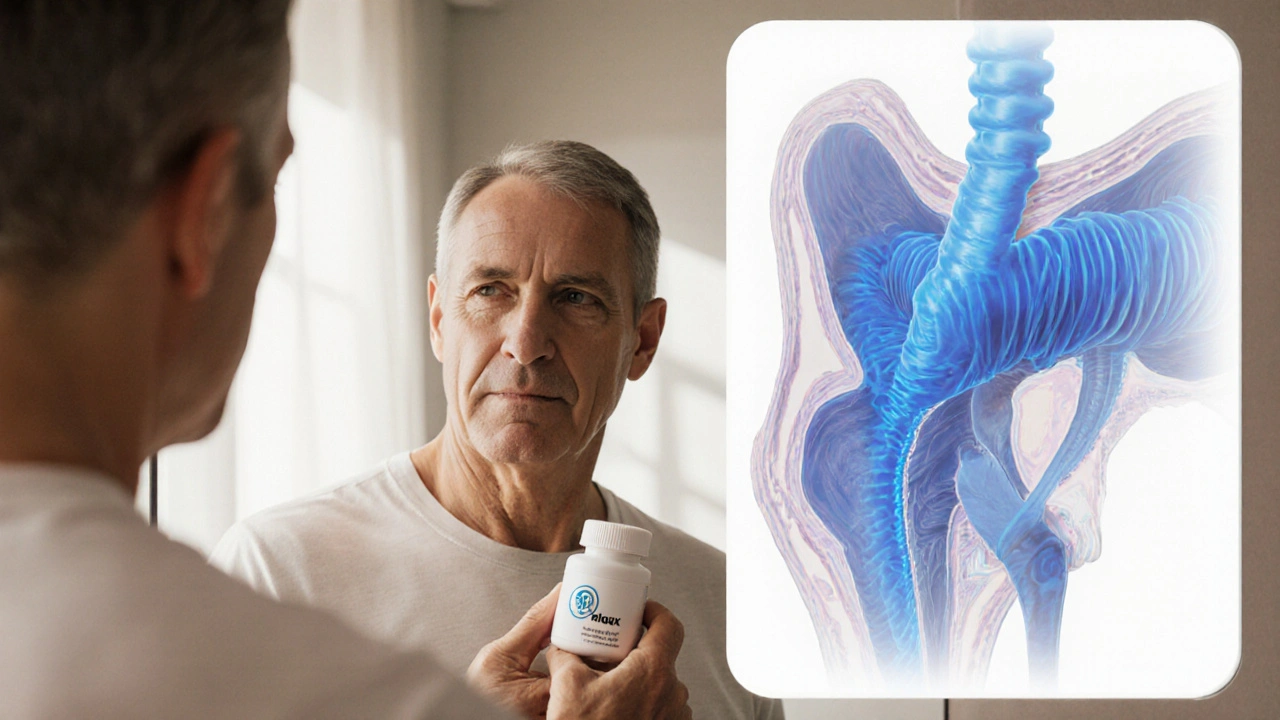BPH Medication Comparison Tool
Recommended Medication
| Medication | Class | Relief Time | Side Effects | Cost (Monthly) |
|---|---|---|---|---|
| Flomax (Tamsulosin) | Alpha-1 blocker | 2-4 days | Dizziness, Ejaculatory issues | $30-$45 |
| Alfuzosin | Alpha-1 blocker | 3-5 days | Headache, Fatigue | $25-$40 |
| Silodosin | Selective alpha-1 blocker | 1-3 days | Retrograde ejaculation | $35-$55 |
| Doxazosin | Alpha-blocker (dual-action) | 4-7 days | Hypotension, Swelling | $15-$30 |
| Finasteride | 5-alpha-reductase inhibitor | 6-12 months | Sexual side effects | $20-$35 |
| Saw Palmetto | Herbal supplement | 4-8 weeks | Stomach upset | $10-$20 |
| Terazosin | Alpha-blocker | 5-7 days | Dizziness, Cold extremities | $12-$25 |
When treating benign prostatic hyperplasia (BPH), Flomax is the brand name for tamsulosin, an alpha‑1 adrenergic blocker that relaxes smooth muscle in the prostate and bladder neck to improve urine flow. It’s taken once daily, usually at a dose of 0.4mg, and has become a go‑to option for many men experiencing urinary hesitancy, weak stream, or frequent nighttime trips.
Why compare Flomax with other options?
Every BPH patient is different. Age, other health conditions, insurance coverage, and personal tolerance for side effects all shape the best drug choice. Comparing Flomax to its peers helps you see where it shines and where another pill might fit better.
Key alternatives on the market
Below are the most common prescription rivals and a popular supplement:
- Alfuzosin - another alpha‑1 blocker, sold as Uroxatral.
- Silodosin - marketed as Rapaflo, very selective for the prostate.
- Doxazosin - a dual‑action alpha‑blocker also used for hypertension.
- Finasteride - a 5‑alpha‑reductase inhibitor that shrinks the prostate over months.
- Saw Palmetto - a plant extract many men try as a natural alternative.
- Terazosin - an older alpha‑blocker used for both BPH and high blood pressure.
Side‑effect profile at a glance
Side effects often dictate whether a patient stays on a drug. Here’s a quick rundown of the most reported issues for each option.
- Flomax: dizziness, ejaculatory problems, nasal congestion.
- Alfuzosin: headache, fatigue, orthostatic hypotension.
- Silodosin: retrograde ejaculation (up to 20% of users), dry mouth.
- Doxazosin: low blood pressure, swelling of ankles, fatigue.
- Finasteride: reduced libido, erectile dysfunction, gynecomastia.
- Saw Palmetto: mild stomach upset, rare headache.
- Terazosin: dizziness, cold extremities, occasional rash.
Cost comparison (average U.S. retail price, 2025)
| Medication | Class | Typical Dose | Onset of Relief | Common Side Effects | Average Monthly Cost (USD) |
|---|---|---|---|---|---|
| Flomax (Tamsulosin) | Alpha‑1 blocker | 0.4mg daily | 2-4days | Dizziness, ejaculatory issues | $30-$45 |
| Alfuzosin | Alpha‑1 blocker | 10mg daily | 3-5days | Headache, fatigue | $25-$40 |
| Silodosin | Selective alpha‑1 blocker | 8mg daily | 1-3days | Retrograde ejaculation | $35-$55 |
| Doxazosin | Alpha‑blocker (dual‑action) | 4mg daily | 4-7days | Hypotension, ankle swelling | $15-$30 |
| Finasteride | 5‑alpha‑reductase inhibitor | 5mg daily | 6-12months | Sexual side effects | $20-$35 |
| Saw Palmetto | Herbal supplement | 320mg twice daily | 4-8weeks | Stomach upset | $10-$20 |
| Terazosin | Alpha‑blocker | 2mg daily | 5-7days | Dizziness, cold extremities | $12-$25 |

When Flomax might be the right pick
If you need quick relief (within a few days) and you’re already on blood‑pressure meds that can tolerate a mild dip in systolic pressure, Flomax often wins. Its once‑daily dosing matches many patients’ routines, and the 0.4mg tablet is easy to swallow.
However, the ejaculatory side effect can be a deal‑breaker for sexually active men. For those patients, a more prostate‑selective drug like Silodosin or a non‑alpha‑blocker such as Finasteride may be preferable.
Choosing an alternative: key decision factors
Use this quick checklist to narrow down the best option:
- Speed of symptom relief: Need relief in days? Choose an alpha‑blocker. Will you wait months? Finasteride or herbal alternatives work.
- Blood‑pressure impact: If you have low baseline BP, avoid drugs that drop it further (Flomax, Doxazosin, Terazosin).
- Sexual side‑effects tolerance: Men worried about ejaculation issues may favor Alfuzosin or Saw Palmetto.
- Cost and insurance coverage: Generic tamsulosin is cheap, but some insurers favor generic Alfuzosin.
- Long‑term prostate shrinkage: Finasteride offers size reduction, which can lower the need for future surgery.
Real‑world scenarios
Case 1 - 58‑year‑old, active lifestyle: John complains of a weak stream but his blood pressure is perfectly normal. He wants to stay sexually active. He tried Flomax and noticed reduced ejaculate volume. Switching to Alfuzosin gave him similar urinary improvement without the sexual dip.
Case 2 - 72‑year‑old, hypertension: Maria is already on an ACE inhibitor that keeps her systolic pressure around 115mmHg. Adding Flomax caused occasional dizziness. Her urologist moved her to Doxazosin at a low dose, balancing BP control and urinary relief.
Case 3 - 65‑year‑old, prefers “natural”: Carlos read about Saw Palmetto and tried a standardized 320mg extract twice daily. After eight weeks his night‑time trips dropped from four to two. He avoided prescription meds but keeps monitoring PSA levels.
Potential pitfalls and how to avoid them
- Sudden drop in blood pressure: Always start alpha‑blockers at bedtime to gauge orthostatic effects.
- Drug interactions: Tamsulosin can increase blood levels of certain antifungals; check with a pharmacist.
- Missing the long‑term benefit of 5‑alpha‑reductase inhibitors: Finasteride takes months to work; combine it with an alpha‑blocker for immediate relief.
- Relying on supplements alone: Saw Palmetto may help mild cases but isn’t proven for severe obstruction.
Bottom line
There’s no one‑size‑fits‑all answer. Flomax delivers fast, reliable symptom relief for many men, but its side‑effect profile and blood‑pressure impact mean alternatives often make more sense. By weighing speed, safety, cost, and personal preferences, you can pick the BPH therapy that fits your life.

Frequently Asked Questions
How quickly does Flomax start working?
Most men notice an improvement in urine flow within 2-4days, though full benefit can take up to two weeks.
Can I take Flomax with blood‑pressure medication?
Yes, but be cautious. Both drugs can lower blood pressure, so start Flomax at night and monitor for dizziness.
What makes Silodosin different from Flomax?
Silodosin is more selective for prostate‑specific alpha‑1A receptors, which may reduce systemic side effects but often causes retrograde ejaculation.
Is Saw Palmetto a safe replacement for prescription BPH drugs?
Saw Palmetto can help mild symptoms, but it isn’t as consistently effective as FDA‑approved medicines for moderate‑to‑severe BPH.
Do I need to take Finasteride forever?
Finasteride works best when used long‑term; stopping it can cause the prostate to grow back to its original size.







Anna Zawierucha
October 4, 2025 AT 16:47Well slap my knee and call it a pharmacy, this guide's got more tables than a restauranteur’s spreadsheet – love the neon‑bright breakdown of Flomax vs. the rest, even if I still can’t decide if I want a steadier stream or a steady libido.
Mary Akerstrom
October 5, 2025 AT 17:47I hear you, the amount of info can feel like a flood, but break it down to what matters to you – if blood pressure is a concern, look at the lower‑dose options first and take it slow, it’ll help you feel more in control.
Delilah Allen
October 6, 2025 AT 18:47Let’s get real here, the pharmaceutical circus loves to drown us in choices, each pill comes with a parade of side‑effects that could make you question why you’re even taking anything at all; you see a table of costs, you see a list of headaches, dizziness, retrograde ejaculation – all delightful reminders that nothing is truly free; the truth is, you’re trading one set of symptoms for another, a classic case of the devil you know versus the devil you haven’t met yet; you might think an alpha‑blocker is "just a pill" but it’s a hormonal hijack, a subtle sabotage of your autonomic equilibrium; the more you read, the more you realize how many pharma‑driven studies are funded by the very companies selling these drugs, so take the data with a pinch of salt; weigh your priorities – is a quick fix worth a possible loss of sexual function, or would a slow‑acting 5‑alpha‑reductase inhibitor be a more dignified compromise?; remember, your body isn’t a laboratory rat, you have agency; the guide is useful, but it’s also a marketing brochure wrapped in clinical jargon, so keep your critical mind sharp; in the end, the decision should align with your lifestyle, your health profile, and your tolerance for side‑effects, not just the cheapest price tag on a monthly bill; that’s the philosophical core – health is a balance, not a binary switch; choose wisely, stay vigilant, and don’t let anyone dictate your bathroom habits.
Nancy Lee Bush
October 7, 2025 AT 19:47Great point! The guide really helps narrow down which med fits a busy schedule – love the clear checklist, thanks for sharing! :)
Dan Worona
October 8, 2025 AT 20:47Ever notice how every new BPH drug comes out right after a big pharma lobbying push? It’s like they’re secretly funding the research to keep us buying their meds, while the "natural" options get shoved to the back. Just saying, keep your eyes open.
Chuck Bradshaw
October 9, 2025 AT 21:47From a clinical standpoint, the efficacy data for tamsulosin versus alfuzosin is nearly identical in the first week, but the meta‑analysis shows a slight edge for silodosin in reducing post‑void residual volume. That said, the retrograde ejaculation rate is notably higher with silodosin, so patient preference matters.
Howard Mcintosh
October 10, 2025 AT 22:47Yo fam this table is lit! I was like "whoa" lookin at the cost vs relief time, now i can tell my doc i want fast relief but not break the bank. Gotta love that quick relief in a few days, now I can plan my day without bathroom panic.
Jeremy Laporte
October 11, 2025 AT 23:47Hey there! Glad you found the cost‑vs‑speed breakdown helpful – just remember to double‑check with your insurance, sometimes the cheaper generic is a hidden gem. Keep an eye on any dizziness, especially if you’re on BP meds.
Andy Lombardozzi
October 13, 2025 AT 00:47When evaluating BPH treatments, it is essential to first establish the primary therapeutic goal: rapid symptom relief or long‑term prostate volume reduction. If rapid symptom alleviation is paramount, alpha‑blockers such as tamsulosin, alfuzosin, or silodosin are appropriate, given their onset of action within days. However, each agent possesses a distinct side‑effect profile that must be weighed against patient comorbidities. For instance, tamsulosin is associated with dizziness and ejaculatory dysfunction, whereas silodosin, while more selective, predominantly causes retrograde ejaculation. In patients with concurrent hypertension, a dual‑action agent like doxazosin may provide ancillary blood‑pressure control, but caution is advised due to the risk of orthostatic hypotension. Conversely, for individuals prioritizing prostate shrinkage, a 5‑alpha‑reductase inhibitor such as finasteride offers reduction in gland size over months, albeit with sexual side effects that can affect compliance. Herbal supplements, like saw palmetto, present a favorable safety profile but lack robust evidence for moderate‑to‑severe BPH. Economic considerations also play a role; generic tamsulosin and alfuzosin are cost‑effective, whereas silodosin may incur higher out‑of‑pocket expenses. Ultimately, shared decision‑making, incorporating patient preferences, comorbid conditions, and financial constraints, leads to an optimal individualized treatment plan.
Joshua Ardoin
October 14, 2025 AT 01:47🚀💊 Wow, that was a deep dive! I love how you broke it down with emojis – makes the medical jargon way more digestible. Thanks for the thorough rundown! 🙌
Glenn Gould
October 15, 2025 AT 02:47Nice guide.